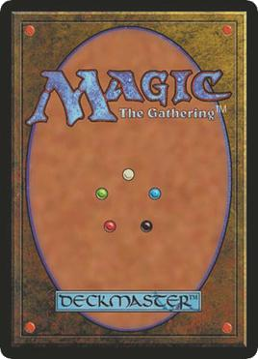 Art by Mike Raabe
Art by Mike RaabeFor people who love to play with robots.
The Artifact cube is a 360 legacy+ unpowered cube which combines both powerful strategies and artifact synergies.
Due to many double faced cards, old mechanics and sometimes not oracle text printing, the cube is best suited for experienced players. It would result in a smoother experience for everyone at the table, even though I've seen new players enjoying the draft without struggling too much.
- The cube has low land fixing. It doesn't need to (because of the high density of uncolored cards and the abundance of mana fixing artifacts), but it means you have to pick them very highly or rely of other colored sources to fix your colors.
- For the previous reason, the signets and the talismans are valuable color fixing cards, and must be evaluated as such.
- While the cube is significantly combo oriented, it features no "2 cards combo" in a strict sense of "oops I win the game". There are nonetheless many A+B interactions which can be considered as combos, like Kinnan, bonder prodigy+Basalt Monolith or Thopter Foundry+Sword of the Meek.
- The environment is structured around two-colors archetypes. There are plenty of innovative decks that you can build, but you'll often be rewarded for following the guidelines and avoiding to spread into too many colors.
- The games can sometimes be very swingy, the aggro decks are very violent, so be cautious of having either a solid controlish early game or a fast mana acceleration if you plan to play 5+ mana payoffs. Like Mono Red in more classic cubes, Aggro can indeed be the fun police.
- Blue is not a control color. No Counterspell in the Artifact Cube. There are some conditional counterspells, but you can't draft a successful draw-go-mono-blue-control-style deck here.
- Creature removal is much less versatile than artifact removal, but also much less frequent: non-artifact creatures are hard to remove and really stick to the board once they resolve, which they pretty much always do.
Here's a summary of the different archetypes in the cube (described in detail below) :

 Affinity
Affinity

 Stax
Stax

 Equipment
Equipment

 Tokens
Tokens

 Storm
Storm

 Sneak & Show
Sneak & Show

 Ramp
Ramp

 Reanimator
Reanimator

 Dredge
Dredge

 Mass Land Destruction
Mass Land Destruction
First of the aggro decks in the cube, Affinity maximizes the value of low cmc artifact creatures to discount their most powerful spells thanks to the affinity for artifacts mechanic. Even though the strategy incentivizes players to draft mostly cheap mana spells, there are several powerful mid-late game options available for the deck, like Digsite Engineer or Urza, Lord High Artificer.
Good to know: Prioritize one drop creatures in the draft, as they are a disputed resource in the cube for aggro, instead of the payoffs which are often more specific, thus more likely to wheel !
Get ready for slow and grindy matches ! Play a game of attrition by creating your own value engine (token generators and/or recursion) while slowly depleting your opponents resources until they run out of gas. Curving your pieces as soon as possible is key to make sure your opponent bites the dust before they can develop enough pressure.
Good to know: You won't be doing much until your first piece of stax is online, so make sure to have either efficient interactions or fast acceleration to survive the early turns !
Grab a sword and go to town ! Fastest aggressive deck in the environment, the archetype is quite simple: play a little creature, give it an equipment, and smash your opponent to smithereens ! To make sure you can reliably assemble your team, there are many equipment creatures in the cube than can fit both roles.
Good to know: There are quite a few lifelinkers in the cube, making attacking not so easy in the late game. Despite needing a solid density of creatures, you'd make good use of blasts and removals to clear the way to victory.
In this cube, Tokens is – like Stax – a control archetype. Your goal is to flood the board with artifacts tokens and then either slow down the game enough to grind your opponent out, or use them to make an explosive game-ending move. While you can go wide with little artifact creatures before pumping them to victory, you have many defensive options that encourages you to play longer games, like Pest Infestation or Staff of the storyteller.
Good to know: White and Green give you everything you need to control the board, but not much to interact with the pile. Against combo, be sure to put some pressure as soon as possible, and attack their mana sources if you can to slow them down.
First and most combo-oriented archetype in the cube, Storm is a deck where you set up a Big Turn with a lot of mana acceleration and card draw before finishing up your opponent with a spell with Storm. This mechanic allows you to copy the spell once for each spell previously cast this turn, resulting in milling the deck of your opponent out, draining 20 life, or dealing 50 damages to their face. Your pieces are often easy to remove, but it's really hard to stop you once you've started your combo, so make sure to get there by disrupting your opponent's hand or by protecting your combo with counterspells.
Good to know: Suspend cards are really potent here as they give you a free spell count at the start of your turn, and are much more difficult to interact for your opponent. Use them wisely and time them well.
This combo archetype is pretty straight forward: draft huge threats then dump them onto the board with cards like Show and Tell or Quicksilver Amulet. While certain cards are indeed close to do so, it will often take more than a single blow to win the game, so prepare for trouble, and make it double.
Good to know: Lack of consistency is the deadliest problem you can fall into when drafting this archetype. Cantrips are really valuable for that reason, draft them very highly if you think you're leaning toward Sneak & Show.
In this cube, no Llanowar elves, but plenty of mana rocks of all sorts to accelerate your mana. Then, you can play cards like Time Spiral to refresh your hand, big threats to overrun your opponent, or end the game with Finale of Devastation for a dozen mana. You also have access to cantrips to smoothen your draws and *landfall* synergies to develop on different axes.
Good to know: As signets and talismans serve for mana fixing as well, it's important to prioritize drafting your enablers (mana acceleration) before your payoffs, especially the few non-artifact ones which are more likely to come back.
Similar to ramp, this all-star cube archetype comes in a new fashion: no Reanimate here, instead you have Trash for Treasure. Indeed, you are bringing artifacts back from your graveyard, not creatures. There are obviously much overlap between the two, and the gameplan remains the same: dump things into your graveyard with looting and discard effects before returning them onto the battlefield ahead of schedule.
Good to know: To reanimate your artifacts, you'll have to sacrifice one in exchange, so make sure to draft one or two drop artifacts to fuel your engine in the early turns of the game, especially those with a "death trigger".
Dredge is another "graveyard matters" archetype : you exploit the self-recursion of cards like Hogaak, Arisen Necropolis to put constant pressure on the opponent and generate card advantage. It's a very resilient aggro/mid-range deck which can also play slower grindy games. You have many options to disrupt your opponent's gameplan (Cankerbloom, Armix, Filigree Thrasher...) and multiple tutors to fetch them (Survival of the Fittest, Buried Alive...).
Good to know: Among the different options available, cards like Lurrus of the Dream-Den and Recurring Nightmare (which provide recursion to your whole team) can be the cornerstones or your deck if you draft around it. Keep them in mind when you're leaning toward Dredge during the draft.
This deck plays pretty much as it reads : destroy everything, notably lands. MLD is a control combo archetype that tries to break the symetry of Armageddon effects by playing indestructible lands and mana rocks. With much more mana left, you get back to shape faster than your opponent, if they're not already dead to a resilient threat developed earlier, like Nissa, Ascended Animist or wurmcoil engine. With lots of board interactions available in red and green, you can also have a more control approach in the draft, prioritizing removals over mana acceleration.
Good to know: The indestructible lands are available in all the 10 guilds, and represent a big part of the scarce color-fixing lands in the cube. Draft them very highly if you can, as they're unlikely to wheel and can disrupt your gameplan pretty significantly.
There are several sub-themes in the cube, and I won't describe all of them, but here are the two most prevalent modules you would want to know before drafting this cube:
Kataki is a dreadful double edge sword: if you can take it early, you can draft a deck full of artifact removals that keep your opponent under water, and as long as you're not drafting artifacts, Kataki is one sided.
Creatures like Reclamation Sage or Sawblade Slinger are important as they play both roles of threat and removal. Finally, creatures tutors in green can fetch for Kataki every game. Remember some lands are artifacts as well !
Even outside a dedicated ramp deck, the land module can be quite strong: with or without the "infinite" dispensed by Fastbond, recurring Strip Mine is often a game breaker. You can also channel Boseiju, who endures every turn, fetch all your basics from your deck with Prismatic vista... It can go in every green archetype if anticipated enough. There are not many fetches in the cube however, don't let them slip away !
- Hallowed Fountain
- Seachrome Coast
- Underground Sea
- Wooded Foothills
- Scrubland
- Verdant Catacombs
- Nurturing Peatland
- Sunbaked Canyon
- Sacred Foundry
- Misty Rainforest
- Diversion Unit
- Repurposing Bay
- Memory Guardian
- Grim Bauble
- Daretti, Rocketeer Engineer
- Dredger's Insight
- Mendicant Core, Guidelight
- Broodheart Engine
- Stridehangar Automaton
- Monument to Endurance
- Aetherjacket
- Cryptcaller Chariot
- Tree of Tales
- Chiss-Goria, Forge Tyrant
- Wight of the Reliquary
- Birthing Ritual
- Transmutation Font
- Warden of the Inner Sky
- Winding Way
- Gaea's Cradle
- Chromatic Sphere
- Sentinel of the Nameless City
- Treasure Vault
- Forgotten Cave
- Jadar, Ghoulcaller of Nephalia
- Frantic Search
- Ravenous Chupacabra
- Virus Beetle
- Arcbound Mouser
- Shifty Doppelganger
- Tezzeret the Seeker
- Scarecrone
- Perilous Myr
- Feldon of the Third Path
- Demonic Tutor
- Ancestral Vision
Hey everyone, Akaru's here to present to you the latest version of the Artifact Cube !
For a little bit of context, it's been a while since I first wondered about increasing the amount of fixing lands in the cube. While it wasn't really a problem for slow and grindy decks to find their color sources, aggro decks like Boros Equipment and Azorius Affinity could sometimes struggle in the first turns of the game to have their 2 colors on turn 2. It resulted in some non games, and that's not something I want, obviously. It was the occasion to balance the fixing between the color pairs with signets/talismans and the ones without, so here we have.
Boros, Golgari and Azorius (the aggro color pairs) get 4 fixing lands now, depending on the choices available and the gameplay patterns.
The 7 others color pairs have 2 fixing lands and 2 mana rocks.
Aetherdrift came with a lot of new artifact matters cards, and even if I wasn't able to fit every one of them in the cube, I tried to include the most interesting ones. Among the notable exceptions, I didn't include Radiant Lotus even though I was willing to give it a try, it is very likely to see the card in a near future to explore new strategies for combo (ramp, storm, etc).
Have fun with the 6.0, I'll be glad to read your feedbacks if you try it ! See you for the next update !

